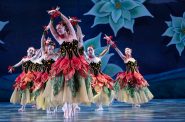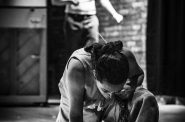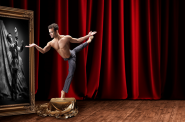Lionel Popkin’s cultural scavenger hunt at Alverno Presents
West Coast choreographer Lionel Popkin set out on a search for the story behind his own inspirations, and fell into a rabbit hole leading to dance pioneer Ruth St. Denis. The resulting "Ruth Doesn't Live Here Anymore" visits Pitman Theatre this Saturday.
Danielle McClune: How did you come to think about Ruth St. Denis, and how it relates to this performance?
Lionel Popkin: When I started making the piece I looked back at my last three pieces, and they were all sort of referencing India in some way. I’m half Indian. In one piece, I cooked curry on stage and passed it out to the audience. In another I addressed the “Ganesh” figure; I had an elephant wandering around the whole time. I wanted to ask myself why I kept doing that. I was born here and grew up here, but there were cultural markers I used that were important to me. So I was starting to think about cultural legacies and then I also was thinking about artistic legacies, you know, I worked with the Trisha Brown Dance Company, but who were her teachers? And so on. And suddenly Ruth St. Denis became an incredible nexus point of both of these conversations.
She was one of the founders of the art forms that we call concert dance and she also did all of these cultural appropriation concepts that were rebelled against early on. She felt like she had conversations going on within her work and that’s fascinating to me, and I went down a rabbit hole. When you start getting into a historical figure like that, it’s an endless trove of information, just things you never thought of. I didn’t set out to make a piece about Ruth St. Denis, it was more about why my pieces kept having these themes to them, and I stumbled into her and it just seemed too good to let go. That’s why the piece became Ruth “doesn’t” live here anymore, to get the sense that she’s important to the process but she’s not the whole.
DM: Tell me a bit about the score for this piece.
LP: It’s an original score by Guy Klucevsek, a well-known accordion composer. We’ve been wanting to work together since we met over 10 years ago, just a mutual “something there.” He has a relationship with the history of the accordion as well as contemporary pieces for accordion. I felt his conversation with the instrument mirrored the conversation I was having about my form. What I didn’t want was a sort of high-form orientalist music, because I thought that would push the theme to the forefront when I wanted to still look past it, and having Guy’s music and his relationship to that instrument felt really appropriate to me.
LP: About 20 years. I would describe my career in three chunks. I left college in ’92 and moved to Seattle and was choreographing for a bunch of people, Then I was with Trisha Brown, which is a larger sized company, and a much broader time commitment, so I kind of stopped making work for four years while I was in her company. And then in ’04 I started making works again. Those are kind of the three stages of my professional life.
DM: Have you ever worked with Alverno Presents? How did you hook up with them?
LP: [AP Artistic Director] David Ravel got a hold of this project fairly early, with the National Performance Network. They committed to the project two or three years ago, so they’ve been on board for awhile, and it’s been great. David’s support has been invaluable. But it’s our first time working together. You know, these conversations happen, you meet people, and it just seems like the right project at the right time.
DM: What do you like the best about this project, maybe even versus the other things you’ve done?
LP: One of the things about the touring life of this project is that—I have to say I like working with original, live music; it’s rare that you get to tour that way. And so far all of the performances are just astonishing. I guess what I really like is that there’s so many different elements—the set and the costumes are really important, there’s a lot video projection with various texts, and then the music…I just couldn’t do it without the music, couldn’t do it without the video, couldn’t do it without any of them; they all really matter in my mind.
DM: Do you tend to work alone, in your own mind? Or do you seek people out to bounce ideas around?
LP: Both. In rehearsal I really value a collaborative process with the dancers, costume designers, videographers–everyone has ideas. It’s my final call; I bring a lot of time outside of rehearsal going through options and things like that, but I would say it’s a combination of both. With this project especially there was a lot of archival research I had to do, I had to go on a lot of trips to be aware of where various things were. But then I’d come back and open up and share with everyone.
DM: If you had to describe your aesthetic, what would you tell people? Or what do you tell people, when they ask what you’re working on?
LP: That’s the tough question (laughs). The live experience is really important to me, and the movement. It’s very physically based but at the same time the people on stage are people, you know? I don’t like to view them as “dancers” but as people who are moving in a particular way. It’s important to me that they register in that way. This piece has a little bit of fireside chat, some monologues at various point within the piece. It’s an attempt to kind of communicate with the audience in that way.
Ruth Doesn’t Live Here Anymore performs at 8 p.m. Saturday, Nov. 16 at Pitman Theatre. Tickets are $35 online.
Dance
-
Milwaukee Ballet Brings Back Orchestra
 Jul 14th, 2025 by Bruce Murphy
Jul 14th, 2025 by Bruce Murphy
-
New Riverwest Company, Production Impresses
 Feb 10th, 2020 by Brendan Fox
Feb 10th, 2020 by Brendan Fox
-
Milwaukee Ballet Show Remakes History
 Feb 10th, 2020 by Catherine Jozwik
Feb 10th, 2020 by Catherine Jozwik






















Very interesting interview with an extraordinarily conceptual choreographer!